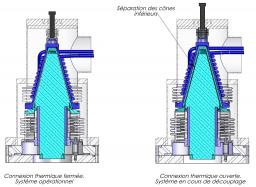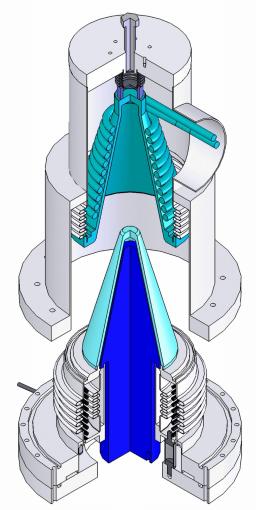It is relatively easy to envisage cooling to the controlled temperature and the extraction of power with helium in gaseous form, but it is more difficult to adjust these two parameters to achieve temperature control to a hundredth of a degree. The first step was taken with the Clas target ten years ago, but it relied upon the condensation of intermediate gases (hydrogen and deuterium) to ensure the required level of stability.
During the tests of superconductors at high critical temperatures, we extended this technique to the temperature range of 5 to 80 kelvins for power of the order of 1 to 10 watts without an intermediate fluid. The technique developed uses 3 levels of exchangers connected in series in order to refine these parameters. The main applications concerned by this process are the Mirim cryostat and the Cétacé test station sample holder.
Within the framework of the nuclear physics project Agata, it is necessary to cool 180 crystals of germanium to the temperature of nitrogen without acoustic vibrations. These crystals are placed in groups of three in 60 cryostats. In addition to the substantial quantities of nitrogen required to absorb the power to be extracted, the vibrations were so loud during the cryostat filling phase that it was necessary to call a halt to the measurements.

Sectional view of the coupling system studied for Agata. The thermal switch is made up of two cones that fit together and move nearer or further apart as required. When the switch is off, the cones are in contact and the mechanical voids are filled with helium gas. When it is open, the cones are kept a few millimetres apart and a rough vacuum is maintained in the volume between them.

3D view of the coupling system studied for Agata during the uncoupling operation. The navy blue central cone is isolated from the exterior by the thermal switch which provides the radiation protection and the vacuum barrier that are essential to maintain it at 80 kelvins.
As an alternative solution, we have proposed cooling these crystals with gaseous helium whose fluidic properties should allow continuous silent operation. We studied a solution using a thermosyphon in gaseous helium, between the crystals and an exchanger cooled with liquid nitrogen positioned far enough away so as not to disturb operation. The studies have shown that this system would be viable within the 5 to 15 bar pressure range at a temperature of 77 kelvins with temperature variance of the order of ten kelvins.
The main difficulty with this detector technology is knowing how to dissociate the crystals from the cooling system when cold. Consequently, we have studied a thermal coupling system fitted with a switch which makes it possible to insulate the crystals thermally during this operation.
These 2 cryogenic studies are important, as they open the way for the thermal use of high-critical temperature superconductors over a large range of temperatures with a good level of operating flexibility.

